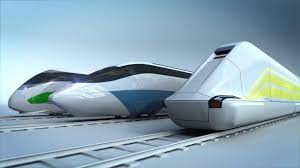The future of sustainable transportation and high-speed rail systems holds promise for revolutionizing global mobility, reducing carbon emissions, and enhancing connectivity between cities and regions. As countries around the world strive to combat climate change and address the challenges of urbanization, sustainable transportation and high-speed rail systems emerge as key solutions for building more efficient, resilient, and environmentally friendly transportation networks. Here’s a closer look at the future of sustainable transportation and high-speed rail systems:
1. Electrification and Clean Energy
The future of sustainable transportation is closely tied to the transition towards electrification and the use of clean energy sources. Electric vehicles (EVs), powered by renewable energy sources such as solar, wind, and hydropower, offer a viable alternative to traditional gasoline and diesel-powered vehicles. Advances in battery technology, charging infrastructure, and renewable energy integration are driving the widespread adoption of EVs, reducing greenhouse gas emissions and dependence on fossil fuels in the transportation sector.
2. Integrated Mobility Solutions
Integrated mobility solutions, including public transit, shared mobility services, and active transportation modes, play a crucial role in promoting sustainable transportation options and reducing reliance on single-occupancy vehicles. Smart mobility platforms, ride-sharing apps, and bike-sharing programs facilitate seamless multimodal travel experiences, allowing commuters to choose the most efficient and sustainable transportation options for their needs. Integrated mobility solutions promote accessibility, equity, and sustainability in urban transportation systems.
3. High-Speed Rail Systems
High-speed rail systems represent a sustainable and efficient mode of long-distance transportation, offering fast, reliable, and energy-efficient travel between cities and regions. High-speed trains, capable of traveling at speeds exceeding 200 miles per hour, provide an attractive alternative to air travel and road transportation for intercity journeys. High-speed rail systems reduce travel times, congestion, and carbon emissions, while enhancing connectivity, economic growth, and regional development along rail corridors.
4. Infrastructure Investments
Infrastructure investments are critical for the development and expansion of sustainable transportation and high-speed rail systems. Governments and transportation authorities worldwide are investing in upgrading and modernizing existing transportation infrastructure, building new rail lines, and expanding public transit networks to accommodate growing demand for sustainable mobility options. Strategic investments in transportation infrastructure support economic development, create jobs, and improve accessibility for communities.
5. Smart Transportation Technologies
Smart transportation technologies, such as intelligent transportation systems (ITS), vehicle-to-infrastructure (V2I) communication, and autonomous vehicles, are reshaping the future of transportation and enhancing safety, efficiency, and sustainability. AI-powered traffic management systems optimize traffic flow, reduce congestion, and minimize energy consumption on roadways. Connected and autonomous vehicles (CAVs) offer the potential to improve road safety, reduce emissions, and enhance mobility for passengers and freight.
6. Sustainable Urban Planning
Sustainable urban planning and land use policies are essential for creating walkable, bike-friendly, and transit-oriented communities that prioritize sustainable transportation modes and reduce reliance on private automobiles. Compact, mixed-use developments, pedestrian-friendly streetscapes, and transit-oriented developments (TODs) promote active transportation, reduce vehicle miles traveled (VMT), and support sustainable transportation choices for residents and businesses.
7. Climate Action and Environmental Sustainability
Sustainable transportation and high-speed rail systems are integral components of global efforts to combat climate change and achieve environmental sustainability goals. By transitioning to low-carbon transportation modes, reducing emissions from the transportation sector, and investing in renewable energy infrastructure, countries can mitigate the impacts of climate change, improve air quality, and promote environmental stewardship. Sustainable transportation initiatives contribute to global climate action agendas and support the transition to a low-carbon economy.
Conclusion
The future of sustainable transportation and high-speed rail systems is characterized by innovation, collaboration, and sustainability. By embracing electrification, integrated mobility solutions, high-speed rail systems, infrastructure investments, smart transportation technologies, sustainable urban planning, and climate action initiatives, countries can create more resilient, efficient, and equitable transportation systems for future generations. Sustainable transportation and high-speed rail systems play a pivotal role in advancing sustainable development goals, promoting economic prosperity, and fostering a more connected and sustainable world.
